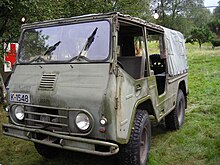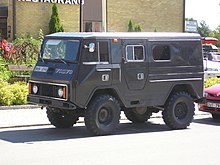
DAF Trucks is a Dutch truck manufacturing company and a division of Paccar. Its headquarters and main plant are in Eindhoven. Cabs and axle assemblies are produced at its Westerlo plant in Belgium. Some of the truck models sold with the DAF brand are designed and built by Leyland Trucks at its Leyland plant in the United Kingdom.

Scania AB is a major Swedish manufacturer headquartered in Södertälje, focusing on commercial vehicles—specifically heavy lorries, trucks and buses. It also manufactures diesel engines for heavy vehicles as well as marine and general industrial applications.

Mack Trucks, Inc., is an American truck manufacturing company and a former manufacturer of buses and trolley buses. Founded in 1900 as the Mack Brothers Company, it manufactured its first truck in 1905 and adopted its present name in 1922. Mack Trucks is a subsidiary of AB Volvo, which purchased Mack along with its then parent company Renault Véhicules Industriels in 2000.

Four-wheel drive, also called 4×4 or 4WD, refers to a two-axled vehicle drivetrain capable of providing torque to all of its wheels simultaneously. It may be full-time or on-demand, and is typically linked via a transfer case providing an additional output drive shaft and, in many instances, additional gear ranges.

Leyland Motors Limited was a British vehicle manufacturer of lorries, buses and trolleybuses. The company diversified into car manufacturing with its acquisitions of Triumph and Rover in 1960 and 1967, respectively. It gave its name to the British Leyland Motor Corporation, formed when it merged with British Motor Holdings in 1968, to become British Leyland after being nationalised. British Leyland later changed its name to simply BL, then in 1986 to Rover Group.
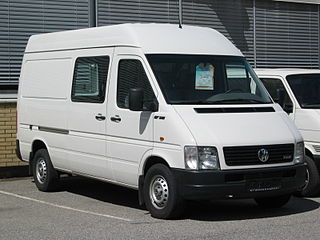
The Volkswagen Transporter LT is the largest light commercial panel van produced by Volkswagen from 1975 to 2006, before being replaced by the Crafter. Two generations were produced.
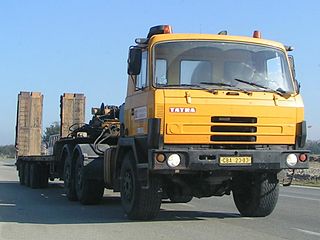
The Tatra 815 is a truck family, produced by Czech company Tatra. It uses the traditional tatra concept of rigid backbone tube and swinging half-axles giving independent suspension. The vehicles are available in 4x4, 6x6, 8x8, 10x8, 10x10, 12x8 and 12x12 variants. There are both air-cooled and liquid-cooled engines available with power ranging from 230–440 kilowatts (310–590 hp). As a successor to Tatra 813 it was originally designed for extreme off-road conditions, while nowadays there are also variants designated for mixed use. The gross weight is up to 35,500 kg (78,264 lb).
In automotive engineering, a mid-engine layout describes the placement of an automobile engine in front of the rear-wheel axles, but behind the front axle.

The Dodge Power Wagon is a four-wheel drive medium duty truck that was produced in various model series from 1945 to 1980 by Dodge. The Power Wagon name was revived for the 2005 model year as a four-wheel drive version of the Dodge Ram 2500. As a nameplate, "Power Wagon" continues as a special package of the four-wheel drive version of 3/4 ton Ram Trucks 2500 model.

Portal axles are an off-road vehicle suspension and drive technology where the axle tube or the half-shaft is off-set from – usually above – the center of the wheel hub and where driving power is transferred to each wheel via a simple gearbox, built onto each hub. This gives two advantages: ground clearance is increased, particularly beneath the low-slung differential housing of the main axles — and secondly, any hub reduction gearing allows the axle halfshafts to drive the same power but at reduced torque. This reduces load on the axle crownwheel and differential.

The B18 is a 1.8 L inline four cylinder automobile engine produced by Volvo from 1961 through 1968. A larger 2.0 L derivative called the B20 debuted in 1969.

Volvo Cross Country C303,, is the base model of a range of military vehicles produced by Volvo.

The Chevrolet Kodiak and GMC TopKick are a range of medium duty trucks that were produced by the Chevrolet and GMC divisions of General Motors from 1980 to 2009. Introduced as a variant of the medium-duty C/K truck line, three generations were produced. Slotted between the C/K trucks and the GMC Brigadier Class 8 conventional, the Kodiak/TopKick were developed as a basis for vocationally-oriented trucks, including cargo haulers, dump trucks, and similar vehicles; on later generations, both cutaway and cowled-chassis variants were produced for bus use.
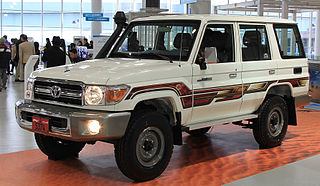
The 70 Series is a family of Toyota Land Cruiser models produced since 1984. It replaced the 25-year-old 40 Series as the off-road model of the Land Cruiser lineup, while the contemporary 60 Series developed into more comfortable luxury SUVs starting with the 80 Series. Despite major changes in styling and numerous technological updates, the 70 Series was designed to retain the off-road capabilities and durability associated with the 40 Series. The 70 Series is marketed throughout the world, except for countries like India, the United States, Mexico, Brazil and Korea where they were imported and put into commercial or private use. As a celebration of the Land Cruiser 70's 30th anniversary, Toyota temporarily marketed the Land Cruiser 70 series in the Japanese market for 12 months.
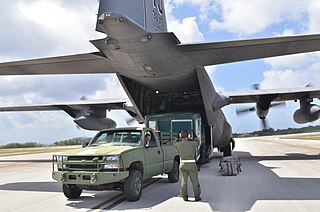
The Commercial Utility Cargo Vehicle (CUCV) is a vehicle program instituted to provide the United States military with light utility vehicles based on civilian trucks.

An articulated hauler, articulated dump truck (ADT), or sometimes a dump hauler, is a very large heavy-duty type of dump truck used to transport loads over rough terrain, and occasionally on public roads. The vehicle usually has all-wheel drive and consists of two basic units: the front section, generally called the tractor, and the rear section that contains the dump body, called the hauler or trailer section. Steering is made by pivoting the front in relation to the back by hydraulic rams. This way, all wheels follow the same path, making it an excellent off-road vehicle.

The Tatra 111 was a truck produced in Czechoslovakia by the Tatra company.
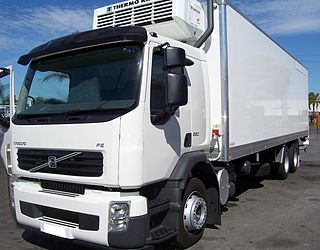
The Volvo FE is a medium duty truck produced by Volvo Trucks Corporation since 2006, now in its second generation. The FE is available in various rigid versions and a tractor version spanning three weight classes.
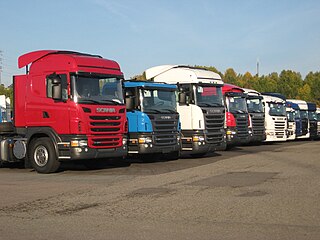
The Scania PRT-range, also referred to as new truck range or Scania's truck range, is the current range of trucks produced by the Swedish commercial vehicle manufacturer Scania. It was first introduced as the successor to the 4-series in spring 2004 with the high forward control cab Scania R-series, followed by the low forward control cab Scania P-series and bonneted cab Scania T-series later in the year. The bonneted model was discontinued in 2005. In 2007 the Scania G-series, a medium forward control cab was introduced and was derived from the R-series. The entire range is modular, giving a wide range of different configurations for different types of trucks. The trucks are available with engines ranging from a 9-litre I5 to a 16-litre V8, with the V8 only being available in the higher model. A second generation launched in August 2016, first was the Scania S-series being the first flat-floor model. In December 2017, a low-end version of the second generation, the Scania L-series, also launched.

The SAMIL 20 is a 2-ton cargo vehicle produced in South Africa in the mid-1980s and was used asthe primary light cargo carrier of the South African National Defence Force. The vehicle design is based on the German Mercedes Unimog chassis and Mark I of this vehicle was based on the Magirus Deutz 130M7FAL 4x4 engine. In Mark II, the engine was replaced with an upgraded South African built water cooled diesel engine. The vehicle is still in use with the SANDF.


